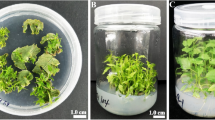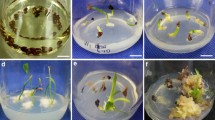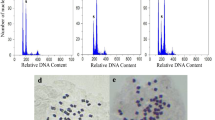Abstract
Seven clones of colchicine-induced tetraploid purple coneflower (Echinacea purpurea L.) plants were grown on a farm for comparison with their corresponding original diploid plants. In the first year of cultivation, the plant height, number of capitula, and inflorescence (branched flower stalk) were significantly reduced in all of the tetraploid plants, while the length-to-width leaf ratio, pollen size, and root thickness were significantly increased. Although the tetraploid plants had larger seeds, most of the seeds of tetraploid plants were not fully filled and the naked seeds (i.e., seeds observed without the outer seed coat) were noticeably smaller than those of the diploid plants. In the second year of cultivation, the phenological stages were markedly delayed in the tetraploid plants; the number of capitula increased much more in tetraploid plants than in diploid plants. Among the seven tetraploid clones, two yielded significantly higher plant biomass and higher cichoric acid content per gram dry weight as well as per plant. The results of the present experiments indicate that some effects of tetraploidization of diploid E. purpurea are genotype-dependent, suggesting that the tetraploidization of more genotypes of the diploid is needed to breed better tetraploid varieties.






Similar content being viewed by others
References
Abdoli M, Moieni A, Badi HN (2013) Morphological, physiological, cytological and phytochemical studies in diploid and colchicine-induced tetraploid plants of Echinacea purpurea (L.). Acta Physiol Plant 35:2075–2083
Adams KL, Wendel JF (2005) Novel patterns of gene expression in polyploid plants. Trends Genet 21:539–543
Ade R, Rai MK (2010) Review: colchicine, current advances and future prospects. Bioscience 2:90–96
Ault JR (2007) Coneflower, Echinacea species. In: Anderson NO (ed) Flower breeding and genetics: issues, challenges and opportunities for the 21 century. Springer, Dordrecht, pp 801–824
Barrett B (2003) Medicinal properties of Echinacea: a critical review. Phytomedicine 10:66–86
Chen ZJ, Ni Z (2006) Mechanisms of genomic rearrangements and gene expression changes in plant polyploids. BioEssays 28:240–252
Chen R, Chen XL, Li QL, Yang YS, Wu H (2012) Micropropagation by repeatedly inducing axillary bud formation of different gene dosage purple coneflower plants. In: Proceedings of the international conference on biomedical engineering and biotechnology, Macao, pp 1056–1059. May 28–30 2012
Chen R, Jin YH, Li QL, Chen XL, Yang YS, Wu H (2013) Some effective methods for dealing with the problem of hyperhydricity in cloning purple coneflower. In: 2013 International conference on biological, medical and chemical engineering (BMCE2013), Dec. 1-2, 2013, Hong Kong, pp 319–325
Chen XL, Chen R, Li QL, Yang YS, Wu H (2013) Cytological comparison of diploid, triploid, tetraploid and hexaploid in purple coneflower (Echinacea purpurea L.). 2013 International conference on biological, medical and chemical engineering (BMCE2013), Dec. 1-2, 2013, Hong Kong, pp 212–220
Cifuentes M, Grandont L, Moore G, Chèvre AM, Jenczewski E (2010) Genetic regulation of meiosis in polyploid species: new insights into an old question. New Phyto 186:29–36
Comai L (2005) The advantages and disadvantages of being polyploid. Nat Rev 6:836–846
Dhawan OP, Lavania UC (1996) Enhancing the productivity of secondary metabolites via induced polyploidy: a review. Euphytica 87:81–89
Doyle GG (1986) Aneuploidy and inbreeding depression in random mating and self-fertilizing autotetraploid populations. Theor Appl Genet 72:799–806
Grange S, Leskovar DI, Pike LM, Cobb BG (2003) Seed coat structure and oxygen-enhanced environments affect germination of triploid watermelon. J Am Soc Hortic Sci 128:253–259
Hansen NJP, Andersen SB (1996) In vitro chromosome doubling potential of colchicine, oryzalin, trifluralin, and APM in Brassica napus microspore culture. Euphytica 88:159–164
Jannoo N, Grivet L, David J, D’Hont A, Glaszmann JC (2004) Differential chromosome pairing affinities at meiosis in polyploid sugarcane revealed by molecular markers. Heredity (Edinb) 93:460–467
Joppa LR, Williams ND (1988) Langdon durum disomic substitution lines and aneuploid analysis in tetraploid wheat. Genome 30:222–228
Kim ED, Chen ZJ (2011) Unstable transcripts in Arabidopsis allotetraploids are associated with nonadditive gene expression in response to abiotic and biotic stresses. PLoS One 6(8):e24251
Koul S, Sambyal M, Kitchlu SK, Bakshi SK, Kaul MK (2010) Development, micropropagation and characterization of colchiploid of Echinacea purpurea (L.) Moench. Indian J Biotechnol 9:221–224
Lavania UC, Srivastava S, Lavania S, Basu S, Misra NK, Mukai Y (2012) Autopolyploidy differentially influences body size in plants, but facilitates enhanced accumulation of secondary metabolites, causing increased cytosine methylation. Plant J 71:539–549
Li QL, Chen R, Chen XL, Yang YS, Wu H (2013) Estimation of the cloning potential in six selected genotypes of purple coneflower (Echinacea purpurea L.). Biotechnol Biotech Equip 27:3911–3917
Luckett DJ (1989) Colchicine mutagenesis is associated with substantial heritable variation in cotton. Euphytica 42:177–182
Majdi M, Karimzadeh G, Malboobi MA, Omidbaigi R, Mirzaghaderi G (2010) Induction of tetraploidy to feverfew (Tanacetum parthenium Schulz-Bip.): morphological, physiological, cytological, and phytochemical changes. HortScience 45:16–21
Muhammad J, Jaskani S, Kwon W, Kim DH (2005) Comparative study on vegetative, reproductive and qualitative traits of seven diploid and tetraploid watermelon lines. Euphytica 145:259–268
Murashige T, Skoog F (1962) A revised medium for rapid growth and bioassays with tobacco tissue cultures. Physiol Plant 15:473–497
Nilanthi D, Chen XL, Zhao FC, Yang YS, Wu H (2009) Induction of tetraploids from petiole explants through colchicine treatments in Echinacea purpurea L. J Biomed Biotech. doi:10.1155/2009/343485
Osborn TC, Pires JC, Birchler JA, Auger DL, Chen ZJ, Lee HS, Comai L, Madlung A, Doerge RW, Colot V, Martienssen RA (2003) Understanding mechanisms of novel gene expression in polyploids. Trends Genet 19:141–147
Sejdler LK, Dabrowska J (1998) Studies on the biology of flowering and fruiting of purple coneflower (Echinacea purpurea Moench). Part 1. Biology of flowering and fruiting. Herba Polonica 42:83–87
Stephens LC (2008) Self-incompatibility in Echinacea purpurea. HortScience 43:1350–1354
Udall JA, Wendel JF (2006) Polyploidy and crop improvement. Crop Sci 46:3–14
Xu CG, Tang TX, Chen R, Liang CH, Liu XY, Wu CL, Yang YS, Yang DP, Wu H (2014) A comparative study of bioactive secondary metabolite production in diploid and tetraploid Echinacea purpurea (L.) Moench. Plant Cell Tissue Organ Cult 116:323–332. doi:10.1007/s11240-013-0406-z
Yoo MJ, Liu X, Pires CJ, Soltis PS, Soltis DE (2014a) Nonadditive gene expression in polyploids. Ann Rev Genet 48:485–517
Yoo MJ, Liu X, Pires JC, Soltis PS, Soltis DE (2014b) Nonadditive gene expression in polyploids. Annu Rev Genet 48:485–517
Zhang XY, Hu CG, Yao JL (2010) Tetraploidization of diploid Dioscorea results in activation of the antioxidant defense system and increased heat tolerance. J Plant Physiol 167:88–94
Acknowledgments
This research was funded by a grant from Science and Technology Planning Project of Guangdong Province, China (2011B031700026).
Author information
Authors and Affiliations
Corresponding author
Rights and permissions
About this article
Cite this article
Chen, R., Jiang, Wz., Li, Ql. et al. Comparison of seven colchicine-induced tetraploid clones with their original diploid clones in purple coneflower (Echinacea purpurea L.). Euphytica 207, 387–399 (2016). https://doi.org/10.1007/s10681-015-1556-3
Received:
Accepted:
Published:
Issue Date:
DOI: https://doi.org/10.1007/s10681-015-1556-3




